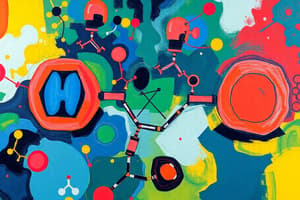Podcast
Questions and Answers
What is the primary precursor molecule from which steroid hormones are synthesized?
What is the primary precursor molecule from which steroid hormones are synthesized?
- Testosterone
- Pregnenolone
- Cholesterol (correct)
- Estrogen
Which cellular organelles contain the enzymes necessary for the synthesis of steroid hormones?
Which cellular organelles contain the enzymes necessary for the synthesis of steroid hormones?
- Endoplasmic reticulum and mitochondria (correct)
- Plasma membrane and cytoskeleton
- Lysosomes and Golgi apparatus
- Nucleus and ribosomes
How do steroid hormones typically enter a target cell?
How do steroid hormones typically enter a target cell?
- By binding to cell surface receptors
- Through diffusion across the cell membrane (correct)
- By receptor-mediated endocytosis
- Via active transport mechanisms
What kind of receptors do steroid hormones interact with within the cell?
What kind of receptors do steroid hormones interact with within the cell?
What is the primary mode of transport for steroid hormones in the bloodstream?
What is the primary mode of transport for steroid hormones in the bloodstream?
Study Notes
Steroid Hormones Overview
- Synthesized from cholesterol, characterized as lipophilic, allowing them to penetrate target cells.
- Initiated through enzyme activation: cholesterol converts to pregnenolone, which further transforms into various steroid hormones.
- Synthesis involves enzymes located in the endoplasmic reticulum (ER) and mitochondria of the cells.
Release and Mechanism of Action
- Steroid hormones are released from cells immediately after synthesis, ensuring prompt action.
- They exert their effects by binding to cytoplasmic or nuclear receptors.
- Upon receptor interaction, they activate specific DNA sequences, initiating protein synthesis.
Examples of Steroid Hormones
- Notable steroid hormones include cortisol, aldosterone, estrogen, progesterone, androgens, and testosterone.
Transport Mechanism
- Steroid hormones circulate in the bloodstream bound to plasma proteins.
- They exhibit high-affinity binding to globulin and low-affinity binding to albumin.
- Sex hormones specifically bind to sex-hormone-binding globulin as part of their transport system.
Studying That Suits You
Use AI to generate personalized quizzes and flashcards to suit your learning preferences.
Description
Explore the fascinating world of steroid hormones, their synthesis from cholesterol, and how they function within target cells. This quiz covers the process of hormone release, their action mechanisms, and notable examples such as cortisol and testosterone. Test your knowledge on these vital biochemical compounds that play a critical role in human health.




